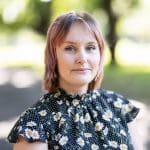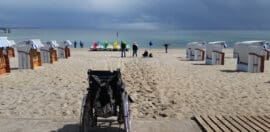Planning for needs of people with disability during disaster

Delegates arrive at the QDN-hosted lunch at the Asia-Pacific Ministerial Conference on Disaster Risk Reduction.
28 September 2022 at 3:42 pm
Australia now has the tools in place for disability inclusive disaster risk reduction, thanks to a co-designed research approach.
After years of extreme floods and bushfires, and with a third La Nina approaching, emergency preparedness is a hot topic.
But people with disability are often left behind in that process. Now, an Australian research program is putting disability at the heart of disaster preparedness.
University of Sydney associate professor Michelle Villeneuve is at the forefront of Australia’s work on what’s known as Disability Inclusive Disaster Risk Reduction (DIDRR).
Put simply, it involves planning for the unique needs of people with disability during disasters.
Bridging the research gap
The research into DIDRR began in Indonesia in 2013, Villenueve explained. At the time, the “fundamental issue” was that disaster risk reduction was not included in disability, and vice versa.
The Indonesia project began to bring the two sectors together.
In 2015 the research arrived on Australia’s radar, and Villeneuve said disability organisations and emergency management groups began to have conversations about what inclusive disaster risk reduction might look like.
The work of researchers including Villenueve has been to bring together three groups of stakeholders to thrash out a path forward: people with disability and their representatives, including carers, allies and friends; the emergency sector, including all levels of government; and service providers of all kinds, including community, disability and health.
This cross sector collaboration has seen Australia’s disaster response become far more inclusive.
Asked why it has taken so long for this inclusivity to come to the fore of emergency management, Villenueve said it followed a wider pattern of exclusion.
“The story of disability exclusion is probably as old as the story of disability itself. As a society… people with disability are typically othered, found in separate systems of education, separated from mainstream employment.
“And so it’s not really surprising that we see them separated as well when it comes to emergency preparedness and planning, because when people with disability are not at the table, their needs aren’t even considered.”
Changing disability from being an afterthought to being front of mind has been a major challenge for researchers, she added.
Person-centred emergency management
Emergency services and governments have been strong supporters of the research, she said, as they seek better information on how to support people with disability.
Villenueve said with greater knowledge between the stakeholder groups, there had been “great traction” in person-centred emergency preparedness tools.
“In 2015 we didn’t have the tools or the rules. Now we have the rules. We’ve been co-designing the tools.”
Those plans and frameworks take into account the function-based supports needed by individuals every day. The frameworks break down the emergency planning process into eight different aspects, including social connectedness, transportation, assistive technology, health management, personal support, communication assistance, animals and living situation.
It is then further broken down into what each individual does, where and how they do it, and how their support needs in these areas are managed each day.
These things are critical for governments and emergency services to be aware of, Villeneuve said.
“To date, everyone has thought about people with disability by their diagnosis or by their impairment, and what we’ve been learning together is how unhelpful that is. If a… stakeholder making an emergency plan for a local council says ‘there are five people with spinal injury in our community’, that provides zero information for planning purposes in an emergency.
“But the person-centred framework provides much more rich information — [for example] ‘we have three people who have equipment that requires power and accessible vehicles to transport them’.”
The frameworks are also helping authorities to build more universally accessible evacuation centres, taking into account not just physical accessibility but connection to information and services that people with disability will need during and in the recovery phase of a disaster.
The person-centred emergency preparedness framework and toolkit has been refined since 2018 with input from people with different types of disabilities from around Australia.
Already, it’s being shared around local councils and integrated into resilience building and disaster planning at that local level.
Villeneuve’s team is also delivering a short course to train service providers about how to coordinate with each other to increase the preparedness of the most at-risk communities.
Peer-led programs
Peers with disability are leading the way in promoting the disaster preparedness approach to other people with disability.
Part of their role, Villeneuve said, is to follow the ‘put your own oxygen mask on first’ philosophy: they have their own emergency contingencies in place first before spreading the word to others.
Having a plan can be a time-consuming process, involving gathering documents, communicating with people about elements of the plan and passing it on to the people who support you and can help coordinate parts of it.
But part of the process is also recognising that disaster preparedness is a journey, Villeneuve said, with the plan evolving and getting better over time.
A key part of the development of the toolkit was the involvement of people with disability and the services that support them.
At that time, she said, no one in that sector had an emergency preparedness plan.
“What was really clear to us back in 2015 was just how new this conversation was for the disability sector and individuals themselves,” Villenueve said.
As the research got underway, Villeneuve got in touch with Queenslanders with Disability Network (QDN).
QDN was keen to work with the researchers to help promote emergency preparedness amongst their members across the state.
Members of QDN have since been leading conversations and supporting others with disability to develop their own disaster preparedness plans, raising awareness of person-centred emergency preparedness with their own lived experience.
Through this process Villeneuve and her team learned a lot about the value of peer support in distributing information.
“When we walk directly through people with disability and their peer groups, they’re really ready and mobilised to have these conversations and also ready and willing to have hard conversations about emergency preparedness,” she said.
The research followed the ‘nothing about us without us philosophy’, co-designing the resources that would help each stakeholder group.
“I always say the voice of people with disability has been central to our work. Emergency services are absolutely at the centre of what we do, but practically speaking they’re not the only voice when it comes to emergency preparedness. Our co-design has had to equally involve government and emergency services, community health and disability service providers because no one person is going to make sure that someone with disability is safe.
“There’s this interdependence and reliance across these sectors to make it work, so the tools we built are really built for collaboration to happen. And I think that’s been the key success of this person-centred framework because it quite naturally brings the stakeholders together at the right point in the preparedness process.”
No one gets left behind
For Michelle Moss, CEO of QDN, Villeneuve’s research is of vital importance.
“It’s really important that we have an opportunity to plan for what needs to happen in a disaster, that we understand what our needs are, what our risks are, and that we can have a plan in place to make sure that we can stay safe and that we can get access to the essential supports that we need around our disability and essential services,” she told Pro Bono News.
Earlier this month, QDN hosted a lunch for more than 70 people at the Asia-Pacific Ministerial Conference on Disaster Risk Reduction (APMCDRR).
Featuring national and international delegates, the lunch was the culmination of a partnership between QDN and the University of Sydney and People with Disability Australia that’s focused on ensuring that people with disability don’t get left behind in disasters.
Villeneuve was there too.
Part of the reason for coming together was to create a “positive force for advocacy” and there are plans to continue the conversation through other forums now that the conference is over.
Villeneuve’s work will see that people with disability finally get a seat at the table, Moss said.
“It’s why we’ve been able to see things snowballing so that people are at the centre and people with disability are part of the conversation, part of the solutions to put plans in place before, during and after a disaster,” she said.
Currently, Moss said, many people with disability don’t have plans in place for what to do in the event of an emergency like a natural disaster.
“We know in the recent floods here in Queensland and New South Wales that a lot of people with disability were cut off from their disability supports. People were left without access to their medication or their essential health needs,” she said.
“People who did try to evacuate and get to somewhere safe weren’t able to get there because there isn’t the transportation in place that they could leave their place safely and evacuate. And when they do get to those evacuation points, often they’re not accessible and they’re not inclusive of people with disabilities.”
The mental health of those caught up in the disaster also took a hit, especially amongst those who had previously felt the trauma of the 2011 floods.
This must change, Moss said – and change is possible, she added, if everyone works together to implement a better system.
With the DIDRR movement growing, Moss said she feels more confident for the future of people with disability in disaster situations.
“[It] is being led by people with disability. And that’s what’s going to make the difference, when people with disability are leading this change. People with disability are ready to be part of making that change happen and working with government and with emergency services and with the community providers to make that happen. But we can only do that when we’re all working together.”







